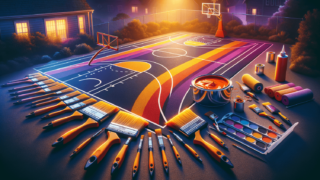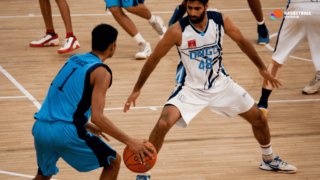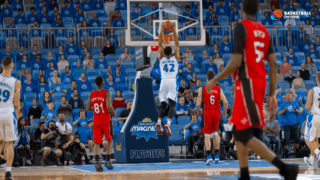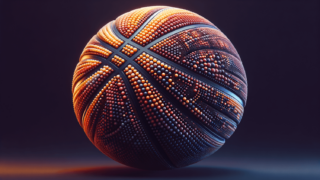
Welcome to the hoop-centric world of basketball shoe longevity! As dedicated ballers and sneaker enthusiasts, we understand that your kicks are more than just gear; they’re an extension of your game, a symbol of your passion, and a crucial investment in your on-court performance. In this blog post, we’ll dive into the fascinating journey of basketball shoe lifespan, discussing factors that can influence durability and providing insider tips on how to keep your sneakers in tip-top condition. So, lace up tight and let’s explore the captivating nexus of style, performance, and durability in the fast-paced realm of basketball footwear.
How Long Do Basketball Shoes Last?
On average, basketball shoes last between 6 months to a year, depending on factors like playing frequency, playing surface, playing style, and shoe quality. High-performance shoes and those with more premium materials may last longer, while more affordable options or shoes worn by aggressive players might wear out faster. To maximize the lifespan of your basketball shoes, proper care and maintenance are essential.
Factors Influencing Basketball Shoe Lifespan
Several factors play a role in determining the longevity of your basketball shoes. By understanding the elements that can impact their durability, you can make more informed decisions when purchasing new kicks and caring for your current collection. Let’s dive into these factors and learn how you can maximize your shoe’s lifespan.
Frequency of Play
It’s no secret that the more you play, the faster your basketball shoes will wear out. The constant pounding, cutting, and jumping on the court gradually takes its toll on your sneakers. Be honest about your playing habits and shoe rotation; if you’re on the court several times a week, your shoes may require more frequent replacement than casual weekend warriors or less frequent ballers.
Playing Surface
The type of surface you play on significantly affects the wear and tear on your basketball shoes. Indoor courts, such as hardwood, provide a consistent and smooth surface, resulting in less potential damage to your shoes. On the other hand, outdoor courts made of concrete or asphalt are more abrasive and can lead to faster deterioration of your shoes’ outsoles and overall structure. If you’re primarily an outdoor player, consider investing in shoes specifically designed for outdoor use, featuring more durable materials and thicker outsoles.
Playing Style
Every player has their own unique game, and the way you hoop can influence how long your basketball shoes last. For instance, explosive players who make frequent hard cuts and jumps may put more stress on their shoes compared to low-impact, strategic players. Additionally, players with a heavier build may experience more rapid shoe breakdown than their lighter counterparts. Stay mindful of your playing style and tailor your shoe selections accordingly.
Shoe Quality and Materials
Not all basketball shoes are created equal. High-quality kicks constructed with premium materials will likely outlast budget options made with cheaper components. Although investing in top-tier shoes may initially hit your wallet harder, they often provide greater long-term value by lasting longer and offering better performance benefits. However, be cautious not to assume a higher price tag always equals longer-lasting shoes; be sure to research and read reviews before your purchase.
Maintaining and Extending Your Basketball Shoe Lifespan
Now that we have highlighted the factors affecting basketball shoe longevity, let’s discuss some practical tips and maintenance habits that you can apply today to stretch the life of your kicks.
Proper Rotation and Rest
Just like basketball players, your shoes need adequate rest to perform their best. Rotating your sneakers allows them to recover, maintain their shape, and reduce long-term wear. It’s recommended to have at least two pairs of basketball shoes to alternate between. Not only will this practice extend the life of your shoes, but it will also allow you to experience different performance qualities on the court.
Indoor Versus Outdoor
As previously mentioned, playing on outdoor courts accelerates the wear and tear of your shoes. If possible, consider having separate shoes for indoor and outdoor play. This practice can effectively prolong the life of each pair and help you maintain peak performance on various court surfaces.
Keep Your Shoes Clean
Regular cleaning not only keeps your basketball shoes looking fresh but also helps extend their lifespan. Focus on the outsoles and midsoles, as dirt and debris can degrade traction and cushioning over time. Use a soft-bristle brush and mild soap to clean your shoes gently. Avoid using abrasive cleaners or hard-bristle brushes, as they can cause damage to the materials.
Proper Storage
Storing your basketball shoes in the right environment can significantly impact their longevity. Store your kicks in a cool, dry, and well-ventilated space to prevent moisture build-up, mold, and material degradation. Avoid placing them near radiators, heaters, or direct sunlight, as excessive heat can warp the shoe’s structure and weaken the glue holding the components together.
Selecting the Right Basketball Shoes for Your Needs
Armed with the knowledge of factors that influence basketball shoe lifespan, as well as how to maintain them, let’s discuss some helpful tips to help you select the best basketball shoes for your specific needs and preferences.
Understand Your Foot Type and Pronation
Our feet come in various shapes and sizes, and understanding your foot’s natural movement—referred to as pronation—is crucial for choosing the right basketball shoes. Pronation types typically fall under three main categories: neutral, overpronation (rolling inward), and underpronation (rolling outward). Each foot type requires different levels of support and cushioning for optimal performance and injury prevention. By researching and trying on various shoes, you can find the best footwear that suits your individual pronation style.
Choose the Appropriate Shoe Height
Basketball shoes come in high-top, mid-top, and low-top versions, each offering unique advantages depending on your playing style and needs. High-tops provide the most ankle support and stability, making them ideal for post players or those prone to ankle injuries. Mid-tops offer a balance between mobility and support and are suitable for versatile players who move around the court frequently. Low-tops are the lightest option, providing enhanced speed and agility for fast guards and those who value mobility over ankle support.
Test the Traction
Strong traction is vital for maintaining balance and control on the court. Basketball shoes with exceptional traction will grip the court surface, allowing you to make quick cuts and explosive moves confidently. The traction pattern and rubber compound used in the outsole play a significant role in determining grip effectiveness. Look for shoes with a multidirectional traction pattern and a rubber compound that’s not too hard or too soft for optimal performance.
Consider Cushioning Type
Cushioning is crucial for protecting your feet and legs from high-impact movements and providing a comfortable on-court experience. Basketball shoes utilize various cushioning technologies, such as Nike’s Zoom Air, Under Armour’s HOVR, or Adidas’ Boost. Research and try on multiple options to find the balance between responsiveness and impact protection that matches your playing style and preferences.
Trusted Basketball Shoe Brands and Models
Exploring the vast world of basketball shoe options can be overwhelming. To help you make an educated decision, here is a list of some popular basketball shoe brands and models known for their quality, performance, and durability.
Nike
As a major player in the basketball shoe market, Nike offers a wide range of models suitable for various playing styles, from the flagship LeBron and Kobe lines to their budget-friendly options, such as the Kyrie Flytrap or Zoom Freak.
Adidas
Another strong competitor in the basketball world, Adidas provides a comprehensive selection that caters to different preferences. Popular choices include the Harden, Dame, and D Rose lines, as well as the budget-friendly Pro Bounce series.
Under Armour
Under Armour, the brand behind Steph Curry’s signature line, delivers exceptional performance footwear. Check out the Curry series for innovative cushioning technologies, along with their renowned HOVR Havoc for a balance of support and responsiveness.
Jordan Brand
A legendary name in basketball culture, the Jordan Brand offers iconic models like the Air Jordan line, which are renowned for their style and performance. Look for the Why Not? series, the CP3 line, or the affordable Jumpman series to suit your needs.
With the insights provided in this blog post, you are better equipped to make smart decisions regarding your basketball shoe choices, ensuring that your investments contribute positively to your on-court enjoyment and success. Remember to always tailor your selections to your specific needs, and never underestimate the importance of proper maintenance and care. Stay fly, ballers!
When to Replace Your Basketball Shoes
Recognizing the signs that your basketball shoes are nearing the end of their life is essential for maintaining peak performance and preventing injuries. Be vigilant and monitor the following indicators that signal it may be time for a new pair.
Traction Loss
As your shoes’ outsoles wear down, you may begin to slip and slide on the court, jeopardizing your safety and efficiency. If you notice your shoes no longer grip the court as effectively or require frequent wiping to maintain traction, consider investing in a new pair.
Reduced Cushioning and Support
The cushioning and support of basketball shoes wane over time, even if the exterior still appears to be in good shape. Pay attention to how your feet and legs feel after playing. If you experience increased fatigue, joint pain, or discomfort, it might be time to upgrade your kicks.
Visible Wear and Tear
Although signs of wear and tear might seem obvious, they can sometimes be more subtle. Inspect your shoes for uneven tread patterns, sole separation, holes, or material damage. If your shoes are visibly compromised, it’s undoubtedly time to replace them.
Fit and Comfort Changes
Basketball shoes can stretch and lose their original shape over time, which can impact your on-court performance. If you notice your shoes have become loose or uncomfortable, consider buying a new pair that provides a snug and secure fit.
Additional Money-Saving Tips and Tricks
Basketball shoes can be expensive, so it’s worthwhile to consider some additional tips and tricks to save money without sacrificing performance or longevity.
Purchase Prior Season Models
Major brands release new shoe models each year, and as a result, older versions often receive significant discounts. Take advantage of these markdowns to score high-quality shoes at a fraction of the original price. The performance differences between current and previous editions tend to be minimal, especially for casual or recreational players.
Shop During Sales Events
Keep an eye on sales events, such as Black Friday or end-of-season sales, where retailers often slash prices on basketball shoes. With some patience and research, you can snag fantastic deals on top-tier models.
Utilize Loyalty Programs and Newsletter Discounts
Many retailers and brands offer loyalty programs, providing loyal customers with exclusive discounts, early access to sales, or cashback rewards. Don’t forget to sign up for newsletters, as many companies occasionally send out subscriber-exclusive promo codes or notify you of upcoming sales events.
Take Advantage of Price-Matching Policies
Certain retailers, both online and brick-and-mortar, have price-matching policies in place. If you find a specific basketball shoe sold at a lower price from a qualifying retailer, the store with the price-matching policy may match or even beat that price. Be sure to read the specific terms and conditions of each store’s policy and take advantage of savings opportunities.
Don’t Overlook Quality Basketball Socks
While focusing on your basketball shoes is essential, never underestimate the importance of quality basketball socks. High-performance socks provide additional cushioning, support, and comfort, which can reduce stress on your feet and prolong the life of your shoes.
Moisture-Wicking Properties
Invest in socks made from moisture-wicking materials that help keep your feet dry throughout the game. Sweat accumulation can cause your feet to slide inside your shoes, leading to instability and increased shoe wear. Materials like polyester or advanced synthetic fabrics excel in wicking away moisture, while cotton socks tend to retain moisture and stretch over time.
Targeted Cushioning and Compression
Quality basketball socks offer targeted cushioning and compression in strategic areas, such as the arches, heels, and balls of your feet. This design can alleviate pressure on your feet, enhance overall comfort, and contribute positively to your on-court performance.
By considering all factors affecting your basketball shoes’ life, adopting proper maintenance habits, and investing in complementary gear like quality socks, you can enhance your basketball experience, safeguard your investments, and enjoy success on the court. With this comprehensive information at your disposal, you’re now prepared for an exciting journey into the world of basketball and ready to make well-informed footwear decisions.
FAQs: Basketball Shoe Lifespan and Maintenance
It’s natural to have questions about how to maximize your basketball shoes’ lifespan and performance. We’ve compiled a list of frequently asked questions to clarify any concerns and help you make smart decisions regarding your basketball footwear.
1. How often should I replace my basketball shoes?
On average, basketball shoes last between 6 months to a year. However, this varies based on factors like playing frequency, playing surface, playing style, and shoe quality. Replace your shoes when you notice signs of significant wear, reduced cushioning, or traction loss.
2. Can I machine wash my basketball shoes?
While some shoes can be machine washed, it’s generally not recommended, as the process can damage the materials and reduce the shoes’ lifespan. Instead, clean your basketball shoes using a soft-bristle brush and mild soap.
3. Can I use the same basketball shoes for indoor and outdoor play?
While you can use the same shoes for indoor and outdoor play, it’s better to have separate shoes for each playing surface. Outdoor courts tend to be more abrasive and cause faster shoe wear; having dedicated outdoor shoes can prolong the life of your indoor shoes.
4. Should I wear my basketball shoes for casual use or other sports?
It’s best to reserve your basketball shoes only for basketball activities. Wearing them casually or during other sports can cause unnecessary wear and tear, reducing their overall lifespan and performance on the court.
5. How do I store my basketball shoes properly?
Store your basketball shoes in a cool, dry, and well-ventilated space to prevent moisture build-up and material degradation. Avoid exposing them to direct sunlight, heat sources, or damp areas, as these conditions can damage the shoes’ structure and components.
6. Are expensive basketball shoes more durable than cheaper options?
High-quality shoes constructed with premium materials typically last longer than budget options made with cheaper components. However, a higher price tag doesn’t always guarantee longer-lasting shoes. Be sure to research and read reviews before your purchase.
7. Can I improve shoe durability by adding insoles or inserts?
Insoles or inserts can enhance comfort and support for your feet, but they typically don’t directly impact the durability of the shoe itself. Nevertheless, improved comfort and support can contribute to better overall playing experiences and reduced wear on the shoes indirectly.
8. Can I repair my basketball shoes if they start falling apart?
It’s possible to perform minor repairs, such as reapplying glue to separated soles, but these fixes are generally temporary. When the shoe’s structure is significantly compromised, it’s best to invest in a new pair to ensure optimal performance and safety.
9. Can shoe deodorizers help extend my basketball shoes’ lifespan?
Shoe deodorizers help eliminate odor-causing bacteria and moisture, which can prevent unpleasant smells and benefit the overall hygiene of your shoes. While deodorizers may not directly impact shoe lifespan, maintaining a hygienic environment within your shoes can contribute to a more enjoyable playing experience.
10. How tight should I lace my basketball shoes?
Lace your basketball shoes snugly, providing a secure and stable fit without cutting off circulation or causing discomfort. This practice ensures optimal support and maintains the shoe’s structural integrity during gameplay.
11. Can I extend the life of my basketball shoes by adding protective coatings or sprays?
Protective coatings or sprays can help protect the shoe’s exterior from minor scuffs or stains, but they typically don’t have a significant impact on the overall lifespan of the shoes. Focusing on proper shoe maintenance and rotation is a more effective way to extend their life.
12. Does brand matter when it comes to the durability of basketball shoes?
While brand reputation can be a factor in shoe quality, it’s essential to research individual models and read reviews to find the best shoe for your needs. Each brand offers a range of models, and quality can vary significantly between them.
13. How can I identify if my basketball shoes are worn out?
Look for signs like decreased traction, reduced cushioning and support, visible material damage, or changes in fit and comfort. If you notice these indicators, it may be time to replace your basketball shoes for improved performance and safety on the court.
Featured Posts
- No pillar pages found.





